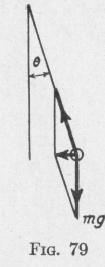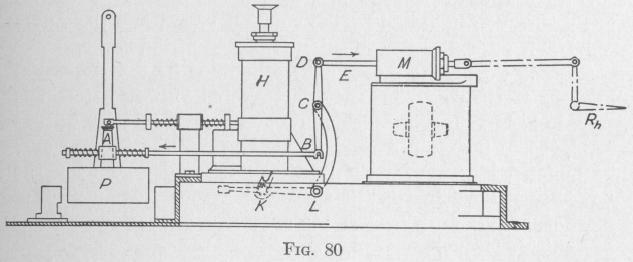94 MOTION OF A SPINNING BODY
The resultant of the angular velocities rwz and Zws is rws. (See Arts. 4 and 6.) From Fig. 78 and the parallelogram law, (Art. 3),
rws2 = rwz2 + 2 rwZ zws cos 0 + zws2
Substituting in this equation the data of the problem as well as the value of rwz from (78), and solving the resulting equation for zws,
zws = 15.5 radians per sec. (79)
Substituting the values now found in (76), the value of the torque acting upon the roll and shaft due to the rotations
LB = -1222(-23)20.12 X 0.99 + 12.9(15.5 - 23 X 0.99)(-23 X 0.12) = -76450 lb.-ft.
The force due to this torque acting on the roll perpendicular to the roll shaft
F = -76450 lb.-ft. _ -12077 lb. wt. 6.33 ft.
The pulverizing ring is acted upon by the horizontal component of the reaction of this force
F, = 12077 cos 6° 40' = 11956 lb. wt.
As the roll shaft is deflected from the vertical through an angle B, there is a horizontal force pulling the roll away from the ring of the value, Fig. 79,
(880 X 6.33 + 600 X 3.33) sin 6
= 142 lb. wt.
f 6.33 cos B
Consequently, the total force with which the roll pushes against the pulverizing ring is
F, - f = 11956 - 142 = 11814 lb. wt.
55. The Automobile Torpedo. - A torpedo that is operated by its own power and is steered automatically
by a self-contained apparatus is called an automobile torpedo. We have torpedoes 22 feet long and 21 inches in diameter that have a speed of 40 knots when submerged and have an effective range of 8000 yards. Such a machine consists of some 3000 parts, costs in the neighborhood of $16,000 and is capable of destroying the largest battleship.
An automatically operating gyroscopic steering device can be set so that after the torpedo leaves the vessel the torpedo will maintain an assigned course which may be either straight or bent. The torpedo can be maintained at an assigned distance below the surface of the sea and caused to sink if it does not strike a target.
All modern automobile torpedoes are operated by compressed gas. The large ones are equipped with two engines of some 700
MOTION OF A SPINNING BODY 95
horse-power, each operating a propeller. The two propellers revolve with equal speed in opposite directions on the after ends of two concentric tubular shafts. The exhaust gases escape through the inner tubular shaft. Some European countries use reciprocating engines, usually of four cylinders arranged radially in a plane perpendicular to the shaft.* The U. S. Navy uses rotary engines.
A reservoir some 12 feet long contains air at a pressure of about 2800 pounds per square inch. After being reduced in pressure to
about 350 pounds per square inch, the air is led into a combustion chamber or " pot " where the temperature is raised by a flame of alcohol or gasoline sprayed into the pot. The fuel spray is ignited by a cordite fuse which in turn is ignited by the explosion of a percussion cap on the launching of the torpedo. The temperature of the pot and contents is prevented from rising too high by spraying into this pot a stream of pure water in addition to the air and fuel. The water flashes into superheated steam thereby adding considerable energy to the working substance.
Gas from the pot operates not only the main motors but also the two steering motors and the turbine that starts the gyro and the one that maintains the spinning.
56. The Pendulum-Controlled Depth Steering Gear. - A horizontal rudder R1,, Fig. 80, operated by piston in a cylinder M maintains the torpedo horizontal at a predetermined depth in the water. The displacement of the piston is controlled by a valve which in turn is controlled by the joint action of a pendulum P and two connected hydrostats, one on either side of the propeller
shaft.
* Dumas, " La Torpille Automobile," Le Genie Civil, p. 401 (1915).

